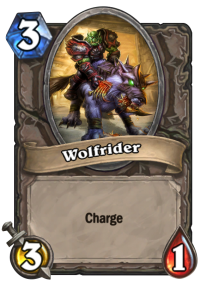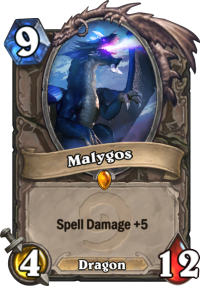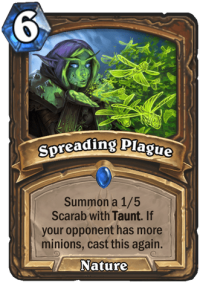You may have noticed that no one is really trying to bash your head in repeatedly when you’re climbing the Hearthstone ladder – this relative recession of aggro strategies is one of the more contentious developments of the Boomsday metagame. It is not just the fact that control decks’ arsenals have caught up to perhaps where they always should have been: crucially, most of the new tools are flexible enough to help out combo decks in a variety of ways in the different matchups, increasing their survivability against the more aggressive archetypes.
Rock-Paper-Rock
Most of you are probably familiar with the classic archetypal trifecta in card games: control decks beat aggro but can’t pressure combo decks enough to stop them from completing their solitaire win condition, losing to them in the process. Combo decks’ strong performances against control archetypes are in turn compensated by their weakness to aggro builds, who are, as we’ve previously discussed, struggling against control. It’s a balanced cycle, one that is slightly tilted in the favor of aggression in Hearthstone due to the premium the game places on tempo.

And yet still, for what seems like the first time in eternity, aggressive decks are not on the forefront of the metagame. Decks like Aluneth Mage are only considered real contenders due to the punishment they dish out on Quest Rogue, and even the faster archetypes are forced to include a set of expensive tech cards to combat the scourge that’s been unleashed in the Year of the Raven. The current well-refined and high-powered decks with fantastic stall options and brutal finishers have made aggro strategies perhaps as weak as they have ever been in the game, and this is due to a multitude of factors.
The obvious ones are the arrival of Giggling Inventor – whose comparison to Sludge Belcher as a strong neutral Taunt by the devs is a bit disingenuous once you consider how many attacks they eat up generally – as a neutral stall option for the midgame and the rise of armor-gaining options for a multitude of classes. Odd Warrior’s hero power upgrade pretty much single-handedly enabled the return of Garrosh’s control archetype, Druid’s incredible abilities in this domain a very well-documented and even Mage joined the fun with Arcane Artificer. Additionally, two neutral utility cards – Gluttonous Ooze and Plated Beetle – plus the Death Knights also provide Armor, which has turned out to be a very useful utility tool: since it can easily stack beyond the standard thirty health, its wider availability puts a massive dent in aggro strategies, forcing most of them to stock up for a longer game during the deckbuilding process.
Total Wipeout
There’s also the increased the consistency of AoE options to consider. For instance, Shaman was already able to chain them together with Lightning Storm, Volcano and Hagatha the Witch, but the addition of Reckless Flurry from a practical joke into a premium card, doubling the class’ reliable board clear options. Not only that, but the new set’s Dyn-o-matic and Supercollider provide options for the sort of board the class has always struggled against: a few mid-sized threats in the mid-game. Warlock and Mage always had a multitude of AoE tools to use and even Hunter has a way now to deal with wide boards thanks to Deathstalker Rexxar’s battlecry, which is one of the more underappreciated reasons behind the rise of the class’ slower archetypes.

Most importantly, many of the new tools that help the already established combo decks – which is, lest we forget, the archetype aggro is supposed to prey on – either buy you a ton of time or double as health-gaining tools. Again, Giggling Inventor is a prime example of this: it doesn’t just stall in Quest Rogue or Token Druid, it’s become an integral part of their win condition. Both Flobbidinous Floop and Dreampetal Florist save you a lot of mana – and therefore time – to pull the rabbit out of the hat, and the former can transform into a taunt minion or a free 3/4 as well in a pinch. Lifedrinker fills a similar role in Shudderwock Shaman and let’s not forget about Ferocious Howl either, which is essentially Shield Block on steroids.

No, I’m not going to mention that card on the right.
The standard strategy of aggressive decks is to take the board early on and dish out enough minion damage until the cavalry arrives that you can eventually finish off the game with burn from your hand – right now, Aluneth Mage is basically the only deck that follows this approach. with mixed success against non-Quest Rogue opponents. With new, potent stalling options diminishing the effects of the former element and ubiquitous armor gain counteracting the latter, it’s become very difficult to rely on a pure aggressive strategy. In a way, this is an interesting change of pace – but the fact that the new sets bolstered the existing archetypes so much that hardly anything new could break through could be considered a problematic development.

The problem is the current combo decks run so many relatively powerful stall, AoE and removal options, that besides odd warrior and controlock (which is arguably a weak deck except in very specific metas, one we are not in right now), there really are not many viable control decks being played. Why? I mean why would you bother grinding out a control win when you can play a total control style then win OTK style ala maly or token druid?
In theory, GI should stall the midgame and make games more drawn out, rewarding players who have incrementally gained value and tempo throughout the game. Instead, it marginally benefits aggro decks (unless you land a fungal or BK shortly after GI, it typically is dealt with fairly easy by control and combo decks who have tool after tool after tool, or it simply gets punished by SP), yet GREATLY benefits combo and control decks. This is to the point that the current “meta” zoolock and even shammy BOTH run mossy horror, a card that SHOULD BE terrible in both decks. So aggro decks actually have to punish themselves to keep up in the meta, whereas combo and control decks can easily run both as mossy only clears their own GI (which, if they are going to play mossy, they obviously can deal with).
What blizzard refuses to address is this imbalance between types of decks. Yeah in a vacuum GI should delay the game and force more thoughts on board trading, etc. And perhaps it does so in arena. Unfortunately all it does in constructed is make OP decks (all druid decks besides I guess spiteful which few people play) even more OP, while giving only a relatively marginal benefit to aggro and midrange decks. I am not saying GI deserves a nerf, rather I am saying that all the tools available to control & combo decks are even further refined by GI, whereas aggro gets a tiny boost (to the point some aggro builds have begun to drop the card, and it never even got picked up in zoo).
The major downside of this being a combo meta is that a lot of these decks play like solitare. For example, quest rogue that doesn’t face aggro… solitare. Odd warrior… solitare. Every druid deck just about with perhaps the exception of when to flip the kill switch on for token or maly… solitare. So even if you personally play an interactive deck like zoo or midrange shaman, your style of play matters less and less, because all that really matters is if your opponent draws the answers and key combo pieces or not.
I for one would prefer to see a huge downgrade in the power of HS so more interactive decks can be played. I choose not to play any druid or quest rogue because if I wanna play a one player game I’ll just go to PvE. But on the other hand for players that really wanna grind to legend, to some extent they are forced to go for these solitare style decks to stay competitive.
GI, BK, SP?
Giggling inventor, ?, Spreading plague.
BK could be black knight but that makes no sense.
Bronze Gatekeeper
Giggling inventor, blood Knight and spreading plague
GI = giggling inventor
BK = blood knight
SP = spreading plague
Good job saving everyone time with that abbreviation there lul